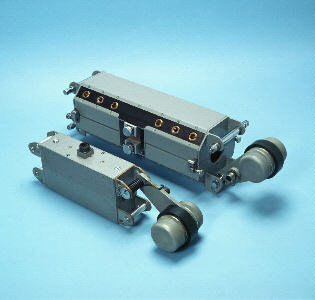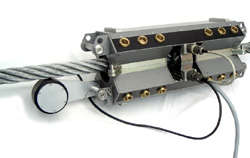|  |
GP Test Heads
[ GP Measuring Heads ]
Equipment for the Non-destructive Magnetic Testing of Wire Ropes
 How
does the sensing head work?
How
does the sensing head work?
During testing the sensing head ensures that the running sector of the wire rope is brought to a condition close to magnetic saturation and provides signals from its sensors to the Meraster MD120 tester. Sensors in the head detect magnetic leakage flux due to external or internal defects in the rope, these defects can be as small as 0.05 % of the rope's cross-sectional area. Heads are intended to detect localised losses, eg from broken wires and pitting corrosion; to detect distributed loss of metallic cross-sectional area, due to corrosion, wear and abrasion; and to estimate the depth of the localised loss position inside the rope. Test results are not affected by plastic coating, grease, etc. Two-piece construction makes it possible to test the rope with only one half of the head, for example testing track rope on the ropeway support This two piece construction also makes it easier to carry the head (i.e. in two parts).
Detecting capabilities of sensing heads vary between
applied sensors.
Meraster applies four categories of sensors in its heads:
- One-channel inductive system, a single coil system used in small heads to correctly detect localised losses.
- Two-channel mixed system, a single coil system and Hall-effect sensing system used in medium heads to detect localised losses and the distributed loss of metallic cross-sectional area.
- Two-channel inductive system (CI-..), a double coil system used in large heads to correctly detect localised losses and to estimate the depth of the position of the localised loss inside the rope.
- Full three-channel system (CIH-..), a double coil system and Hall-effect sensing system used in large heads to detect localised losses; to estimate the depth of the position of localised losses inside rope and to detect the distributed loss of metallic cross-sectional area.
General Characteristics
Output: Inductive coil signals vary between defect, rope and sensor sizes and testing speeds, in the range microvolts to volts AC.; Hall-effect sensor signal is typical on microvolts/milivolts level with larger DC component
 Operating
Temperature Range: -25 to +40°C
Operating
Temperature Range: -25 to +40°C
Supply: Not required for inductive coil sensors. Controlled supply required for Hall-effect sensors.
Lead length: 10 m is standard, or longer on request
RI Rope Length Converter
In order to measure the running rope length (and speed
of relative movement), heads may be equipped with a special transducer
to indicate rope/head movement as an electric signal. Meraster recorders-defectographs
also use it to synchronise the strip chart feed with the rope/head travel
and to compensate for speed influence on the inductive coil signal.
Output : Encoder type 2 x 100 pulses/m ; 0/+12V
Supply : +12V/+5V dc
Standard lead length: 10 m
| DIMENSIONS
mm |
HEAD | SENSOR | ROPES
mm |
HOLE
mm |
WG.
kg |
MAIN APPLICATIONS |
|---|---|---|---|---|---|---|
| 630x224x244 | GP-1 | CI-1a (double coil) | 30-90 | 100 | 60 | Winding ropes in mining winders, carrying and hauling ropes in aerial ropeways |
| GP-1h | CIH-1a (full) | |||||
| 610x192x192 | GP-2S | CI-2a (double coil) | 20-64 | 75 | 45 | |
| GP-2Sh | CIH-2a (full) | |||||
| 610x193x184 | GP-2 | CI-2a | 20-60 | 75 | 44 | Special for carrying ropes in aerial ropeways |
| GP-2h | CIH-2a (full) | |||||
| 400x88x150 | GP-3Ar | single | 10-35 | 40 | 18 | Hauling ropes in aerial ropeways and funicural railways, ropes in drilling rigs and cranes |
| GP-3Arh | double, mixed | |||||
| 268x66x106 | GP-4 | single | 10-26 | 33 | 6.3 | As above |
| 282x66x68 | GP-5 | single | 8-15 | 20 | 5 | Ropes in cranes |
| 188x152x92 | GP-6-4 | 4singles | 8-14 | 20 | 8.5 | Four-rope lift instalation |
| 188x222x92 | GP-6-6 | 6singles | 8-14 | 20 | 12.5 | Six-rope lift instalations |
Zawada
NDT
![]()
Language
versions
English Main
Page
MD120 Wire Rope Defectograph:

PC Card,
Optional Hardware and Software for PC
|
Measuring Heads:
|
E-mail:
zawada@z-ndt.com
Fax:
+48 32 376 7900
Phone:
+48 32 271 6231
Mail:
Zawada NDT
ul. Tatarkiewicza 8
PL- 41-819 Zabrze
POLAND
Office/Visit:
ul. Roosevelta 120 B-5
(GPS: Roosevelta 118)
41-800 Zabrze


